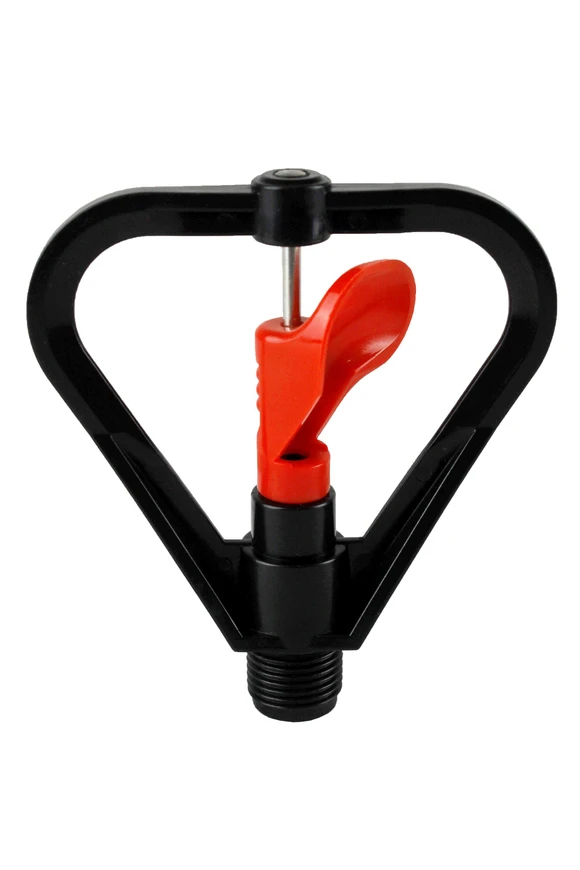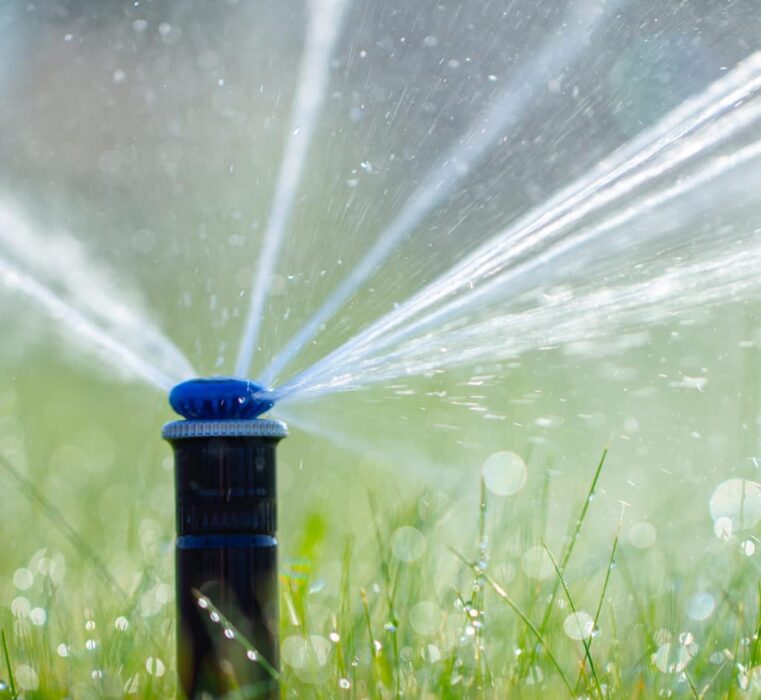
Types Of Sprinkler Irrigation Systems
Grekkon Limited’s has all types of sprinkler irrigation systems for agriculture. From the giant flange type rain guns, to the tiny micro sprinklers. Here detail how each works, and the prices
Types of Sprinkler Irrigation Systems: Price and Specifications
1. Rain gun sprinkler prices and specifications
These are for broad acreage
| Type | Make | Inlet Diameter | Max Spray Diameter | Min Head (Pressure Rating) | Max Flow Rate | Price in Kes |
| Flange | Metallic | 2″ | 60M | 40M | 60M3/ Hr | 65,000 |
| Flange | Metallic | 1.5″ | 40M | 40M | 45M3/ Hr | 50,000 |
| PY 50 | Metallic | 2.5″ | 45M | 30M | 25M3/ Hr | 19,000 |
| PY 40 | Metallic | 2″ | 35M | 30M | 17M3/ Hr | 17,000 |
| PY 30 | Metallic | 1.5″ | 30M | 30M | 8M3/ Hr | 15,000 |
| RM | Metallic | 1.5″ | 30M | 30M | 8M3/ Hr | 17,000 |
| Plastic | Plastic | 1.5″ | 30M | 25M | 7M3/ Hr | 5,000 |
| RM | Metallic | 1″ | 20M | 30M | 6.5M3/ Hr | 6,500 |
2. Impact sprinkler prices and specifications
For smaller acreage, open filed crop
| Make | Inlet Diameter | Max Spray Diameter | Min Head (Pressure Rating) | Max Flow Rate | Price in Kes |
| Plastic | 1″ | 12M | 10M | 3M3/ Hr | 1,250 |
| Plastic | 3/4″ | 7.5M | 10M | 2M3/ Hr | 750 |
| Plastic | 1/2″ | 5M | 10M | 1.5M3/ Hr | 450 |
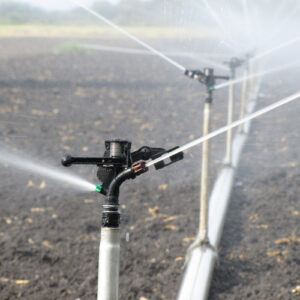
3. Pop up sprinklers
For lawns, parks, and gardens. The are sub surface units, which under pressure rise (pop up) to irrigate.
| Make | Inlet Diameter | Max Spray Diameter | Min Head (Pressure Rating) | Max Flow Rate | Price in Kes |
| Plastic | 3/4″ | 12M | 10M | 3M3/ Hr | 4,500 |
| Plastic | 1/2″ | 7.5M | 10M | 2M3/ Hr | 2,500 |
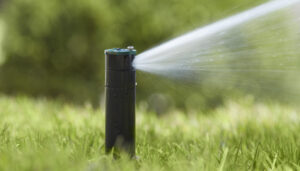
Types of sprinkler irrigation systems: Others
Other smaller sprinkler types for small gardening are butterfly sprinklers, and micro sprinklers. They have low coverage and an inlet of 1/2″
Micro sprinklers today irrigate large acreages of orchard. They are attached to a sub-main line, taking the pace of button drippers

Micro sprinklers in an orchard
How To Select The right Type of Sprinkler Irrigation System
- By crop. Lawn grass will thrive better with pop ups
- Water availability. Rain gun sprinklers demand the most amount of water
- Generation of pressure. Micro sprinklers work with the least pressure
- Budget. Pop up systems are the most expensive , and sophisticated
Overhead Sprinklers For Irrigation
Grekkon Limited is an irrigation equipment supplier in Kenya. We design, supply, and install all types of overhead sprinklers for irrigation systems, for every acreage and crop. Our overhead sprinklers for irrigation in Kenya are of different types, for different crops, acreage and locations. This is why our technical or agronomy team will visit a grower who needs to install one
It is to assess the land layout and size, topography, water location, water volume, existing water pump if any, and the crop. Through this survey, we recommend the most appropriate sprinkler irrigation kit for the grower based on their budget. For instance, a grower with 100 acres of orchard will have a different sprinkler from a 100 acres of a park covered with grass. Similarly, a farmer on an 1/8 acres of cabbage will have a different sprinkler irrigation kit than the one with 30 acres of cabbage
Overhead Sprinklers For Irrigation
Types
We have these 5 overhead sprinklers for sale types shown below available. For most, there are both metallic and plastic versions. Metallic sprinklers have a longer lifespan, but are costlier and heavier. Plastic sprinklers are lighter, cheaper, but have a shorter period of operation. The body material does not affect the pressure rating, inlet and outlet sizes or the water discharged. For technical details on each type, click on the title links given for every sprinkler
- Rain gun sprinklers for medium-sized to large acreage. Available sprinkler sizes are; 1″, 1-1/4″, 1-1/2″, 2″, and 2.5″. We supply and install the double nozzle PY, Atom, and flange type rain guns. The latter are for broad acreage and require very high water volume, and high operating pressure
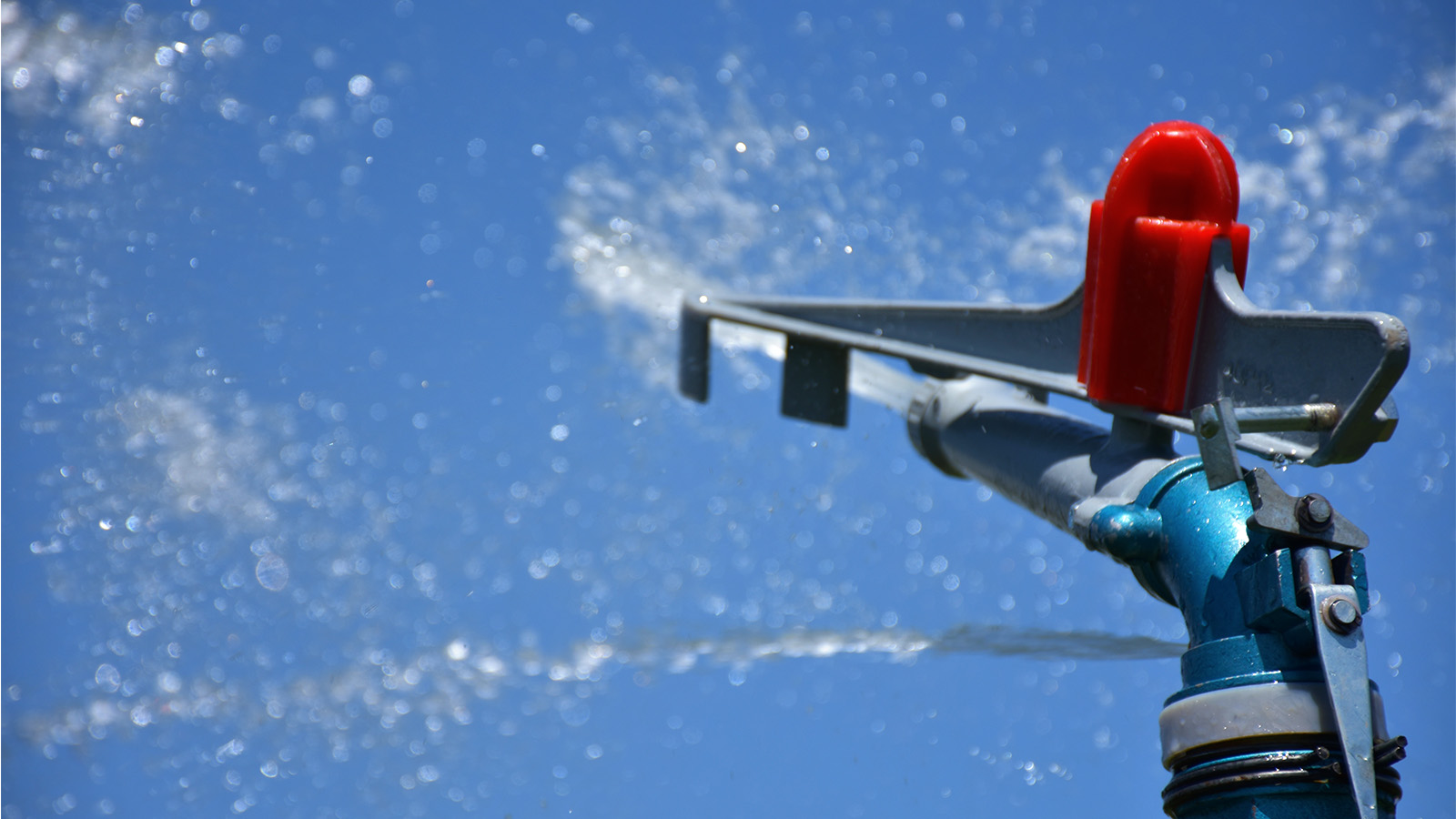
An ordinary size rain gun sprinkler at work after installation by Grekkon Limited
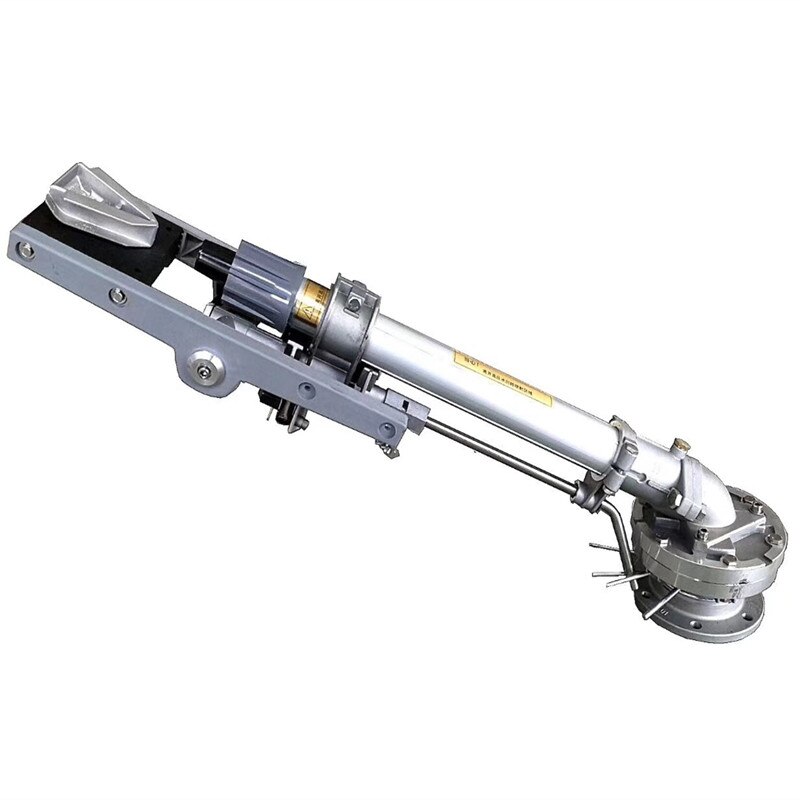
2.5″ giant flange type rain
A flange type rain gun video at work
2. Plastic or brass impact sprinklers for small to medium sized acreage. Our sizes are; 1/2″, 3/4″ and 1″ which have either 2-way, 3-way or 4-way nozzles
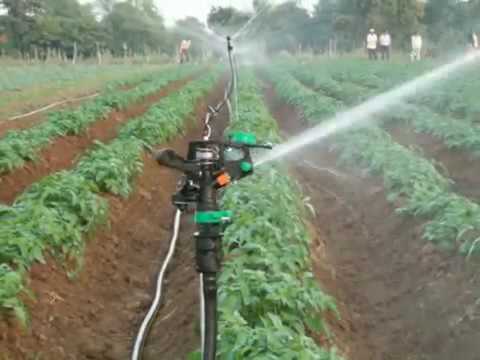
Plastic impact sprinklers
3. Mega-net sprinklers for small to medium-sized areas. We have the 1/2″, 3/4″ and 1″ which have a spray angle of 180 degrees
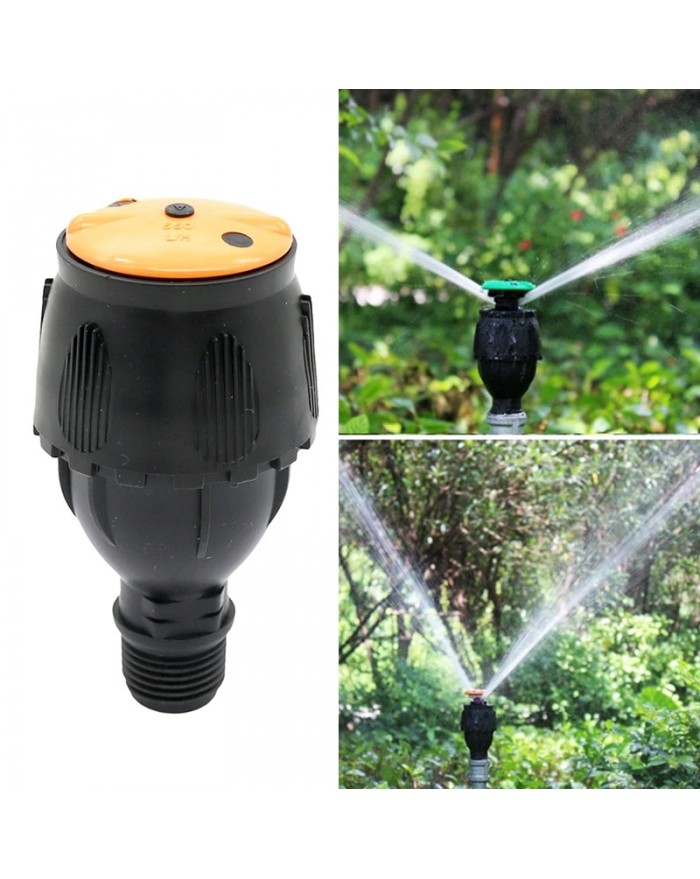
A mega net sprinkler
4. Micro sprinklers for orchards and small areas with a spray angle of 360 degrees
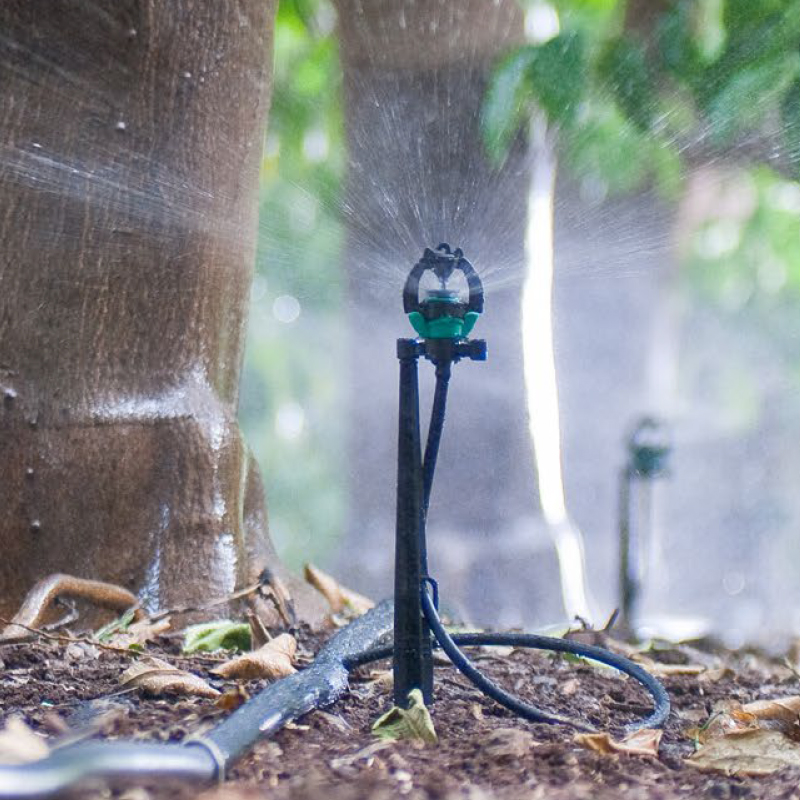
Micro sprinklers in an orchard
5. Pop up sprinklers for lawn irrigation. Our sizes are1/2″ and 3/4″ which spray up to 360 degrees
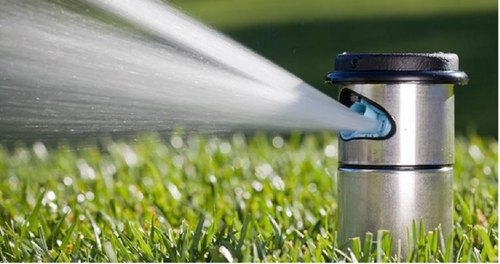
A lawn pop up sprinkler
6. Butterfly mini sprinklers for small gardens or and lawns available as 1/2″
How to choose your overhead sprinklers in Kenya
- Land size. Rain guns for large acreage, and micro-sprinklers for small plots of land
- Crop type. Pop-ups for lawn irrigation, all other sprinklers for field crops
- Ground elevation. Gravity power from high elevations will swing micro and impact sprinklers. Rain guns, Meganets, and pop-ups work with water pumps
- Grower’s budget. It determines the sprinkler type and number of units to install
Our sprinkler irrigation system design considers the above 4 factors during our site visits conducted before a sprinkler irrigation system is installed
Components of an overhead sprinkler irrigation system
- Mainline. This is PVC, HDPE, or GI to supply water from the source. It will be connected directly to the sprinkler riser pipe, or to the sub-main line
- Sub mainline. This one is connected directly to the sprinkler rise pipe, or to the sprinkler itself from the mainline. It is also PVC, HDPE, GI or a delivery/ layflat pipe
- Riser pipe. This receives water from the main line or sub-main line to the sprinkler It is also PVC, HDPE, or a GI
- Tripod or pipe stand. It is the sprinkler’s support structure
- Gate valves. They allow or block water flow to the sub mainline
Overhead sprinkler prices in Kenya per acre
- Rain gun sprinkler system from Kes 65,000
- Impact and Mega-net sprinklers from Kes 50,000
- Butterfly and Micro jet sprinklers from Kes 85,000
- Pop-up sprinklers from Kes 120,000
FAQs
A. What are the pros and cons of an overhead sprinkler irrigation?
I. Overhead sprinkler irrigation advantages
- There is a wide choice to select from
- It is easy to install
- It is cheaper than drip irrigation
- Easy to move from one point of the farm to another
II. Disadvantages
- It is water wasteful
- During strong winds, water distribution is uneven
- High running cost because a water pump is needed
- It requires labour to move it from one location to another if it’s a portable system
B. How does an overhead sprinkler irrigation system work?
- Water is pumped under high pressure from the source; tank, reservoir, lake, river to the mainline
- From the mainline, it is distributed to the sub-main lines
- From the sub-mainlines, it enters the sprinklers under pressure. This pressure swings the sprinkler in a circular motion
- The sprinkler breaks the water into fine droplets, which fall on the crop
C. How do I choose a water pump for my sprinkler system?
Consider the following when selecting a sprinkler water pump
i. Pressure rating of the sprinkler. The water pump’s pressure rating must exceed that of the sprinkler to compensate for pressure losses in the piping system. Grekkon Limited’s technical team advises growers on the best match. The larger the pipe diameter, the lower the pressure loss along the horizontal pumping distance. The longer the horizontal and vertical pumping distance, the greater the pressure loos. Pressure loss during irrigation water reticulation is also as a result of leakages along the piping system
ii. Discharge rate of the sprinkler. Like the pressure rating above, this will be higher for the water pump to cater for any fluid losses
iii. Inlet diameter of the sprinkler. That of the pump has to match this
D. Which sprinkler head is best?
Rotor sprinklers are the most efficient sprinklers in the market. They have the least run-off, and irrigate slowly, hence less wastage
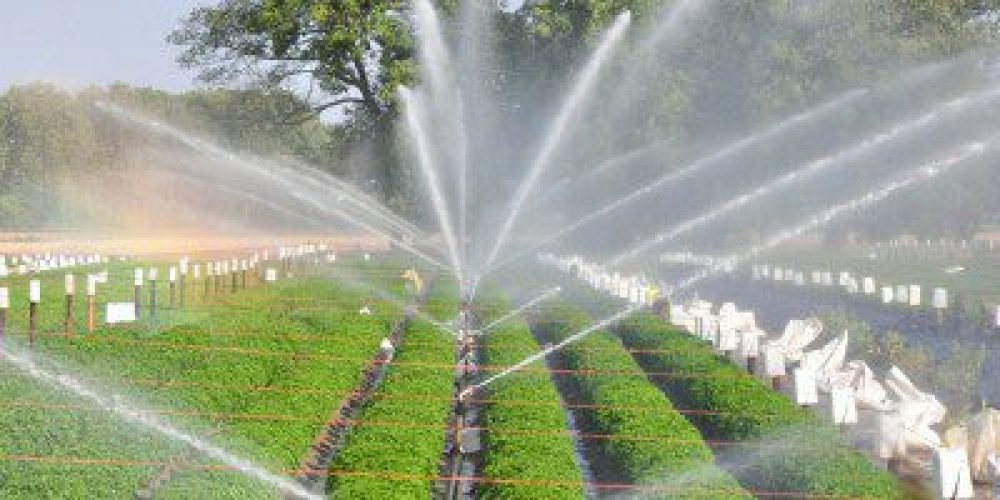
Water Sprinklers
Water sprinklers for sale in Kenya by Grekkon Limited are categorised by size. The sprinkler size determines the place of use, as a result of the unit amount of water it gives. Water sprinklers in Kenya are either plastic or metallic. This affects the price and longevity, but not the water volume.
1. Garden Sprinklers
These have an inlet diameter of 1″, 3/4″ and 1/2″. Garden sprinklers have low water volume, and are for home gardening. This includes; kitchen gardens, small scale farms, lawns, hedges, and flower beds. Their irrigation diameter is 3M to 14M according to inlet size and make.
Examples
1.1. Butterfly sprinklers
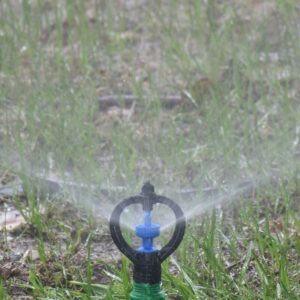
1.2. Mega net sprinklers
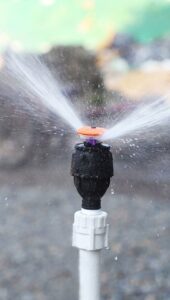
1.3. Impact sprinklers
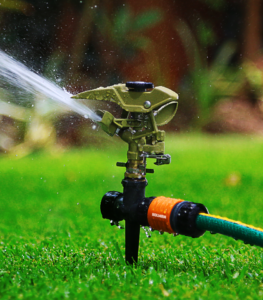
Metallic impact sprinklers
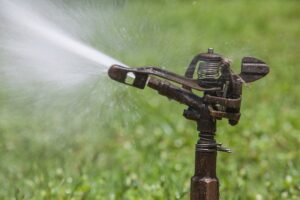
Plastic impact sprinklers
1.4. Pop up sprinklers
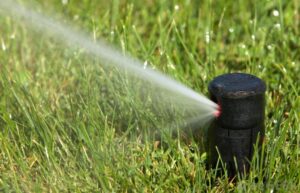
1.5. Lawn sprinkler
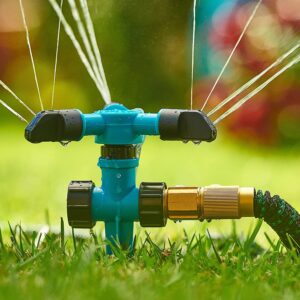
1.6. Sprinkler jet micro sprinkler
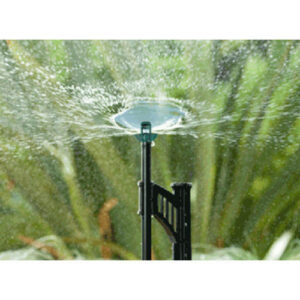
Garden Water Sprinklers Prices in Kenya
A commonly asked question; How much does a sprinkler cost in Kenya?
The table below answers this
| Type | Inlet Diameter | Max Spray Diameter | Min Head (Pressure Rating) | Max Flow Rate | Price in Kes |
| Impact Sprinklers | 1″ | 12M | 10M | 3M3/ Hr | 1,250 |
| 3/4″ | 7.5M | 10M | 2M3/ Hr | 750 | |
| 1/2″ | 5M | 10M | 1.5M3/ Hr | 450 | |
| Butterfly & Micro Sprinklers | 1/2″ | 3M | 3M | 0.1M3/ Hr | 150 |
| Mega net Sprinklers | 3/4″ | 10M | 20M | 0.3M3/ Hr | 250 |
| 1″ | 14M | 30M | 0.5M3/ Hr | 350 | |
| Pop up Sprinklers | 1/2″ | 7M | 20M | 2M3/ Hr | 2,750 |
| 3/4″ | 14M | 30M | 3M3/ Hr | 3,750 |
2. Rain gun sprinklers
These are larger sprinklers to irrigate small to large acreage of commercial crop. They vary in size and make.
2.1. Flange type rain guns
They are giant rain guns that evacuate large amounts of water, and work under high pressure. They are in large plantations
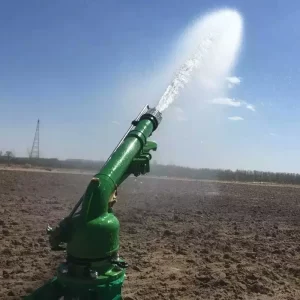
A flange type rain gun in a large field
2.2. Atom rain gun
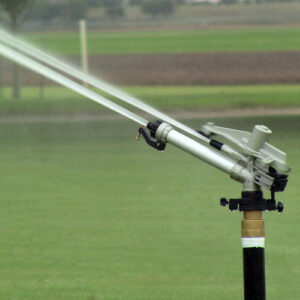
2.3. PY type rain gun
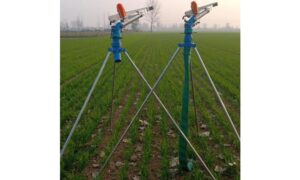
2.4. Plastic rain gun
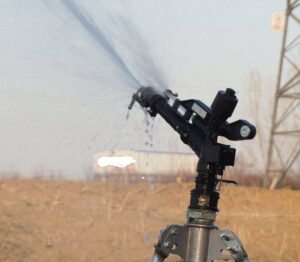
Rain gun price in Kenya
| Type | Make | Inlet Diameter | Max Spray Diameter | Min Head (Pressure Rating) | Max Flow Rate | Price in Kes |
| Flange | Metallic | 2″ | 60M | 50M | 60M3/ Hr | 65,000 |
| Flange | Metallic | 1.5″ | 45M | 40M | 40M3/ Hr | 50,000 |
| PY 50 | Metallic | 2.5″ | 40M | 30M | 25M3/ Hr | 19,000 |
| PY 40 | Metallic | 2″ | 35M | 30M | 17M3/ Hr | 17,000 |
| PY 30 | Metallic | 1.5″ | 30M | 30M | 8M3/ Hr | 15,000 |
| Atom/ RM | Metallic | 1.5″ | 30M | 30M | 8M3/ Hr | 17,000 |
| Plastic | Plastic | 1.5″ | 30M | 25M | 7M3/ Hr | 5,000 |
| Atom/ RM | Metallic | 1″ | 20M | 30M | 6.5M3/ Hr | 6,500 |
Micro Sprinklers In Kenya
Micro sprinklers in Kenya by Grekkon Limited are low-pressure, low to medium volume irrigation equipment that are ideal for micro-irrigation. They deliver water directly to the crop root zone, in a uniform manner. They provide full scale surface irrigation, and localised watering of crops. Micro sprinklers are used for; fruit tree, lawn, hedge, and small garden irrigation
Micro sprinkler price in Kenya
The unit cost of all types of sprinkler jet micro sprinklers at Grekkon Limited is from Kes 100 at any of our branches nationwide. Micro sprinkler price per acre is a factor of the number of units used, which depends on the crop spacing. For instance tree tomato spaced at 2M x 2M will require a higher number of micro sprinklers than avocado spaced at 6M x 5M
Each unit is composed of 3 parts; the sprinkler, the 8mm diameter connecting tube, and a 1-1/2′ long plastic support stand
Micro sprinklers save water through high application efficiency, and uniformity of spray. They are a substitute for button drippers where drip irrigation is impractical, but create a larger wetted area than drip irrigation. Micro sprinkler irrigation provides low precipitation which allows for longer watering time with low run-off. They are available in a wide range of plastic configurations. Micro sprinkler sets are used with fertigation systems which save on fertiliser application labour cost. They are also light in weight and small in size, which makes them highly portable, and easy to install
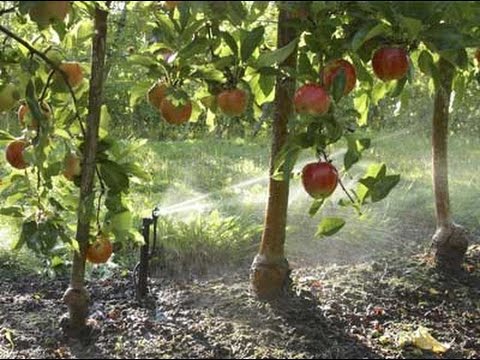
Micro sprinklers watering an apple crop
What is micro sprinkler irrigation?
It is micro irrigation through the adoption of sprinkler jet micro sprinklers, set at the base of the plant
Micro Sprinklers In Kenya
Coverage:
Micro sprinklers coverage is a factor of; flow rate, wetting diameter or radius, and the wetting degree.
1. Operating pressure; from 15M head / 1.5 bar – 20M head/ 2 bar. Pressure lower than this will cause the micro sprinkler to release large droplets, or cease rotation. These droplets will be unhelpful, or even destructive to the work undertaken
2. Flow rate 40 litres per hour
3. Irrigation degree; available as 90, 180, and 360 degrees
4. Irrigation dimeter; 1.5M to 3.5M. This is an important factor to note during installation because it guides on the spacing of one sprinkler jet micro sprinkler to another
Micro sprinklers work when positioned upright, or upside down. Upright when they’re standing on the ground for normal irrigation. Upside down when set in a greenhouse, or open field crop to provide humidity to a mature crop or seedlings. This upside down placement is also for keeping plant foliage moist, or for overhead irrigation.
They deliver irrigation water through micro tubing to a series of nozzles attached to risers. They have small to medium sized droplets with good uniformity of coverage, and lower precipitation rate.

How to space micro sprinklers
Micro sprinklers placement is in such a manner that the sprays overlap. If for instance the irrigation diameter is 1.5M, the distance between micro sprinklers will be 2.25M. This ensures that there are no dry spots in between. An overlap ensures full coverage particularly for lawns, hedges or very closely spaced crops
How to use micro sprinklers with fruit trees
Our micro sprinklers for orchards are installed this way: Set one micro sprinkler per tree, 30cm or 1 foot from the base of the tree trunk being irrigated. Unlike online or button drippers which work well with gravity, a water pump will be necessary when irrigating with many micro sprinklers. This is because they need an operating pressure of 15M – 20M head, which is best achieved by a water pump
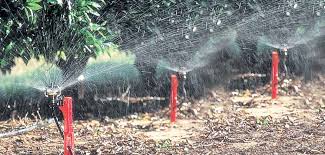
How much water do micro sprinklers use?
They use a maximum of 40 litres per hour
Micro Sprinklers In Kenya
FAQs
1. How effective is micro sprinkler irrigation?
It reduces water usage by 25% to 40% compared to impact or rain gun sprinkler irrigation, and by 45% to 60% when compared to surface irrigation. They provide uniform water application which ensures uniform growth and crop maturity
2. How far apart should sprinkler jet micro sprinkler be?
It should be less than the radius of their spray. See details above under the heading how to space micro sprinklers
3. When do you use a micro sprinkler?
Like drip irrigation, they are great for water conservation. However, unlike drips they create a humid micro climate around the crop, which is important in the control of certain pests such as spider mites, arphids, and thrips,
4. What are the disadvantages of micro sprinkler irrigation?
4.1. The tubes get clogged more easily than those of an impact sprinkler or rain gun sprinkler. This is because they are much smaller than those of other sprinkler types
4.2. They are more expensive to install than drip lines, or button drippers
4.3. They require higher operating pressure than drip lines, or button drippers, hence the need to invest in a water pump
4.4. They require a higher level of expertise during installation than button drippers, or drip tapes
4.5. The rate of water loss due to evaporation is higher than with a button dripper, or drip irrigation system
4.6. Many units are required per unit of land compared to other larger sprinklers
5. How do micro sprinklers work?
They have micro tubings which deliver water to small openings that release it at a slow rate, as fine particles. They apply water directly to the soil surface allowing it to percolate under low pressure
6. How far do micro sprinklers spray?
1.5M to 3.5M diameter
7. What are the components of a micro-irrigation system?
7.1. A pumping station to provide the right pumping pressure
7.2. A filtration system to capture any debris or dirt that will clog the system
7.3. Mainlines. These are the pipes originating from the pumping station, and feeding the sub-main lines. They are the largest pipes
7.4. Sub-main lines. These are the pipes origination from the main lines, and feeding the laterals. They are smaller in diameter than the main lines
7.5. Laterals. These the pipes connecting to the sub-main lines, to which the micro sprinklers are attached. They are the smallest pipes in diameter
These pipes will be either be of the high density polypropylene (HDPE), or poly vinyl chloride PVC type
7.6. Hydrants. These are the irrigation control units in the field from which water is channelled to various blocks
7.7. Venturi system. This is a chemigation and/or a fertigation unit connected to the main line. It is the point from which soluble fertiliser and drenching pesticides are fed into the irrigation system
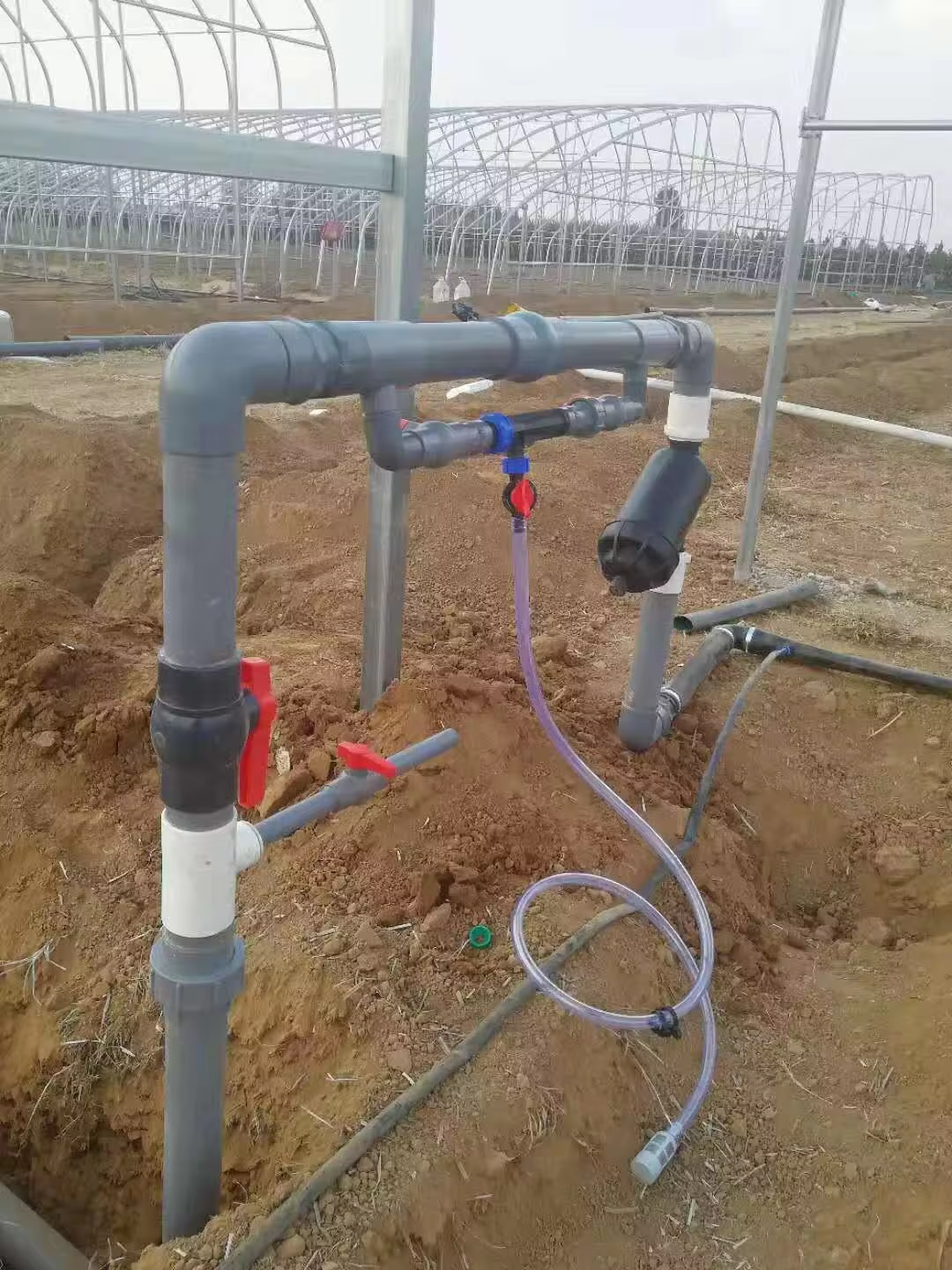
A venturi fertigation – chemigation unit being set up in an upcoming vegetable farm by Grekkon Limited
7.8. The sprinklers. They water the crops directly
8. How long to run micro sprinklers in Kenya?
35 to 45 minutes is sufficient time at optimal flow rate and working pressure
9. What is the difference between drip irrigation and micro sprinklers?
Drip irrigation is for closely spaced crops that require targeted irrigation. Micro-sprinkler irrigation is for sparsely spaced, larger crops or crops that grow best under overhead irrigation
10. What is the difference between mini and micro sprinklers in Kenya?
Mini sprinklers are larger, with a greater flow rate and operating pressure to cover a bigger area. They are better for smaller plants or landscape irrigation
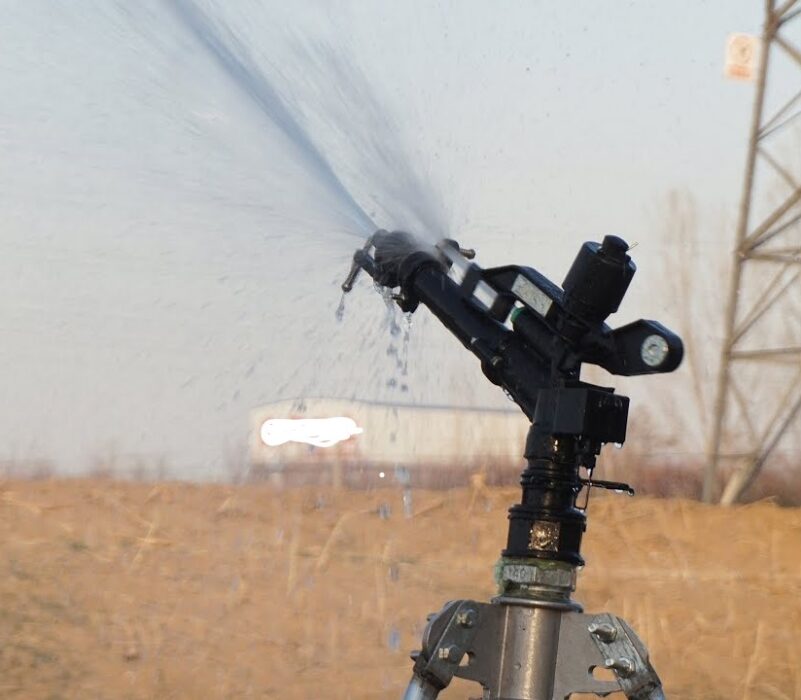
Plastic Rain Gun Sprinkler
Our plastic rain gun sprinkler in Kenya is the Shrub body style whose application is both domestic and industrial. Grekkon Limited’s low pressure plastic rain guns are 1-1/2″ in size. It is a double nozzle with additional detachable nozzles as; 6mm, 8mm, 12mm, and 16mm
This irrigation sprinkler is lighter than it’s metallic counterpart, but with a shorter longevity. It makes it highly portable to reach any point in your farm. It is black in color because it is made from high density polyethylene material (HDPE). This material is UV- treated to reduce it’s degradation by the sun, thus extending the sprinkler’s working life. UV treatment is an important quality in tropical climates where radiation is high. Every tropical grower ought to consider this because it impacts the working life of the rain gun sprinkler
This irrigation rain gun for sale works with water pumps to provide requisite pressure. The necessary water pump specs are:
- It will be electric, diesel or petrol powered
- It must provide a minimum pressure of 3 bars,and a discharge of 8 cubic liters per hour
- The outlet pipe is 1-1/2″ and above. A delivery, HDPE or PVC irrigation pipe evacuates the water from the pump to the sprinkler.
The rotation is up to 360 degrees. A farmer will adjust the rotation area manually as necessary using the pins below the nozzles. All metallic parts are rust proof and the rubbers are easy to replace once they wear out. Our plastic rain gun sprinkler features a friction collar and a trip lock, and are also provided with a jet breaker for uniform water application
Types of rain gun sprinklers
1. Plastic
2. Metallic; PY type, Atom and the flange type rain gun sprinklers. Learn more here; https://grekkon.com/rain-gun-sprinklers-2/
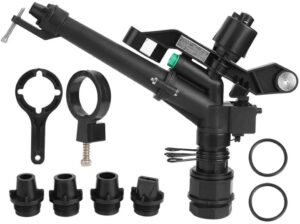
Plastic Rain gun sprinkler specifications and price
| Type | Body Type | Inlet Diameter | Max Spray Diameter | Min Head (Pressure Rating) | Max Flow Rate | Price in Kes |
| Plastic | Shrub | 1.5″ | 30M | 25M | 7M3/ Hr | 5,000 |
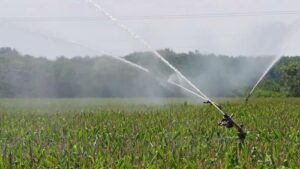
Plastic Rain gun
Product benefits
- This is ideal for newly cleared areas
- It reduces irrigation time
- Low labour cost
- High efficiency
- Improves humidity or creates a micro-climate
- It is easy to maintain and use
- Irrigates a much wider area than conventional smaller impact sprinklers
Disadvantages of rain gun irrigation
- It consumes a large amount of water
- The need for a high amount of power makes it costly to operate
FAQs
1. How much horsepower (Hp) is required for a rain gun?
This depends on the rain gun sprinkler size. The larger it is, the greater the discharge, and so the greater the power needed. Another factor is the number of rain guns set to run at a go. Generally, it is from 8.5Hp
2. Is rain gun good for irrigation?
Yes it is. However, do not irrigate on crops that are highly susceptible to fungal infections with overhead irrigation. Examples are; tomato, potato, capsicums, and others
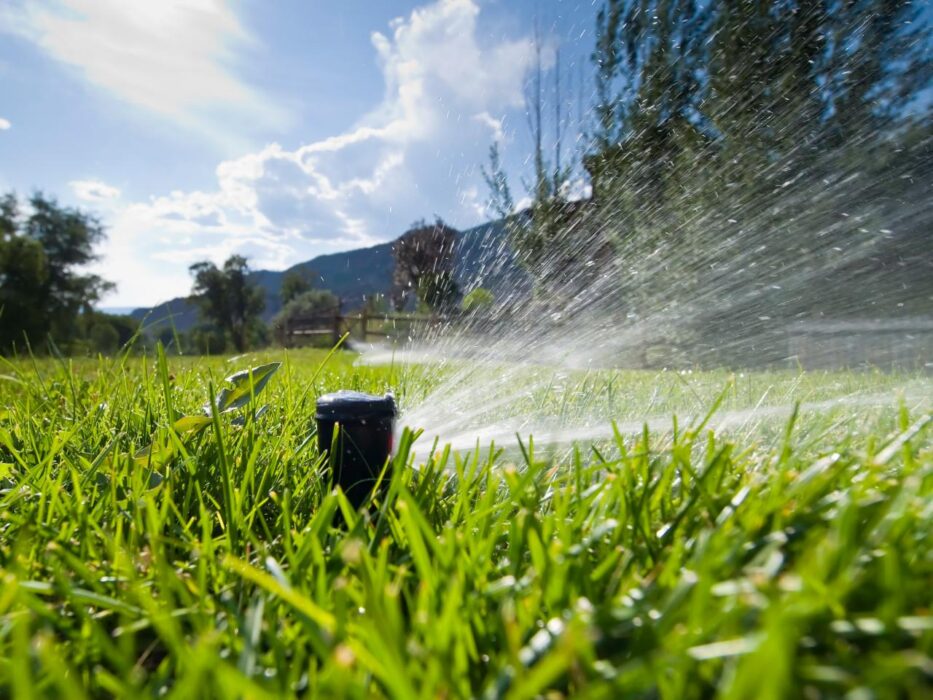
Pop-Up Sprinkler Kits In Kenya
Grekkon Limited’s pop-up sprinkler kits in Kenya are designed for lawns and gardens. As a lawn irrigation company in Kenya, we design your lawn irrigation system layout, then install your pop up sprinklers. Our pop-up sprinklers have inlet sizes of; 1/2″, and 3/4″. This inlet size determines the amount of water discharged, and the pop up sprinkler radius
Components of a Lawn Irrigation Kit
- Electric surface water pump. The size of the electric water pump, and motor power is determined by the area under irrigation
- HDPE pipe; your HDPE pipe diameter size is from 32mm (1″) in diameter to 63mm/ 2″ depending on the size of the area under irrigation. The pipe’s thickness is PN8 through PN16 depending on the pressure power of the electric water pump
- HDPE fittings; 32mm (1″) tees, elbows, adaptors and end caps. They connect the HDPE pipe to the water pump, to each other, and to the pop-up sprinklers
- Timer. This is for an automated system. It switches the pop-up sprinkler irrigation system on and off according to the timings set
Pop-up Sprinkler Kits Price In Kenya
Pop-up Kit Prices Tabulation
Area In Meters Square Number of Pop up Sprinklers Pop up Sprinkler Inlet Size Cost In Kes 50 1 1/2″ 12,000 100 1 3/4″ 18,000 500 (1/8 acre) 5 3/4″ 75,000 1,000 (1/4 acre) 9 3/4″ 125,000
The given pop-up sprinkler kits cost includes an electric water pump
Types of Pop-Up Sprinklers
There are 2 types of pop-up sprinklers by Grekkon Limited
Spray irrigation heads
Spry irrigation heads have a working pressure of 14M to 20M head. They they are for small to medium sized spaces. Each is placed at a maximum distance of 4.5M from each other. Spray irrigation heads give out a fine mist, fast, and irrigate evenly. They are not recommended on windy days or windy locations
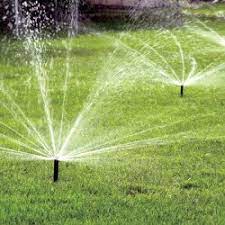
Spray irrigation head pop up sprinklers
Spray rotary heads
They are rotary with a working pressure from 20M head, and are for medium to large spaces. This is because they deliver water slowly in a stream, instead of a fine mist. Spray rotary heads are good for slow draining soils and slopes. Their spacing is from 6M
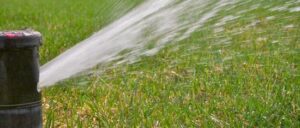
Spray rotary head pop-up sprinkler
Pop-Up Sprinklers Spacing
As shown above, the sprinkler spacing is a factor of the type of sprinkler, and also the size. Sprinklers’ spray will overlap to avoid ‘dry blind spots’
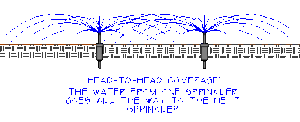 The spray jet from each sprinkler should extend to the other sprinkler for full coverage
The spray jet from each sprinkler should extend to the other sprinkler for full coverage
How To Install Pop-Up Sprinklers
Our sub-surface pop-up sprinklers kit is piping is 40cm below ground level as illustrated below
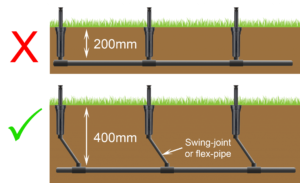
The sprinklers have laterals to a HDPE main line. This pipe’s diameter is according to the amount of water needed
The laterals from the main line carry water to the sprinklers. This depth secures the pipes against damage from the surface
Steps To Repair A Pop-up Sprinkler Head
When pop-up sprinklers age, the heads will sometimes, get stuck in position so it doesn’t rotate, chip or break. If this oocurs, follow these steps below to fix your pop-up sprinkler head
- Cut out a circular area around the pop-up sprinkler, about 15cm to 20cm in diameter
- Remove the intact grass around the sprinkler. This way, you’ll return it as it was after the repairs to the same location
- Unscrew the faulty sprinkler from it’s rider
- Replace the old head with a new one of a similar size
- Screw back the new sprinkler
- Adjust the new sprinkler head to direct the spray where you need it
- Turn on the water to test the new sprinkler, to remove any dirt/ debris, and to check for any leakages on your new connection
- Return the cut out grass
Pop-up Sprinkler Kits In Kenya
FAQs
1. How deep do pop-up sprinklers need to be?
Not more than 40cm below surface. This avoids accidental punctures of the pipe, and allows easy assessment or improvement
2. How many pop-up sprinklers can you put on one zone?
The number of pop-up sprinklers installed by Grekkon Limited in a unit area are a factor of;
2.1. Pop-up sprinkler inlet diameter/ size. The larger the diameters, the lessor the units needed
2.1. Water pump size. The larger it is, the more sprinklers it runs per unit area
2.3. Location factors. presence of obstacles such as trees, rocks, hedges and so on
3. How long should you run pop-up sprinklers?
This depends on the discharge rate of the sprinkler. The 9L per minute sprinklers need 15 to 20 minutes to completely water a section. The 2.5L per minute ones need an hour
4. How much water does a pop-up sprinkler use per minute?
The average is 5.5 litres
5. What height should pop-up sprinklers be set at?
10cm above ground when irrigating
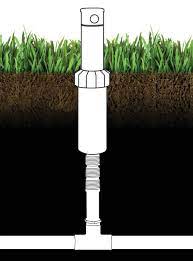
6. How much pressure do pop-up sprinklers need?
This is 20M to 35M head
7. Can you mow over pop-up sprinklers?
Yes you will mow over it, but have the motor off
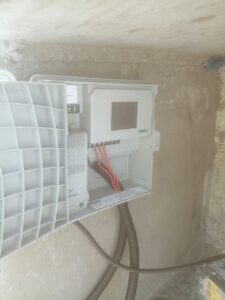
A pop up sprinkler timer installed for a project at Vipingo, Kilifi county
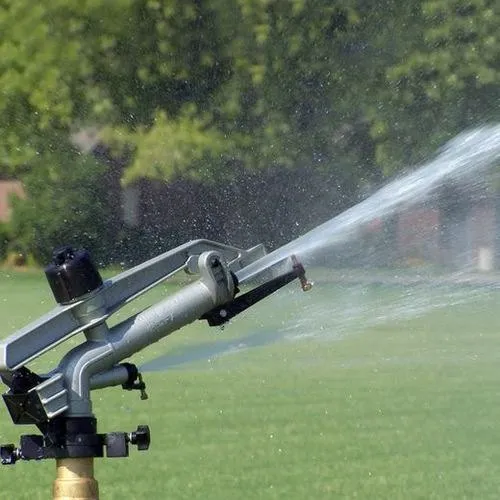
Long Range Sprinkler
Our long range sprinkler models irrigate large acreage of horticulture, fruit, corn, wheat, barley, canola, and potato crops. Every long range sprinkler in Kenya by Grekkon Limited is from 1-1/2” to 2-1/2” inlet diameter size. These sprinklers provide fine rain drop sized watering in the field when operating at optimal capacity
Long range sprinkler specifications
- Material. Aluminum, brass, and steel
- Nozzle sizes. 12mm, 16mm, 18mm, and 20mm
- The diameter of spray. 35M to 40M for the 1-1/2” and 45M to 60M for the 2”
- Discharge volume. 15 cubic to 30 cubic per hour for the 1-1/2” and 20 cubic to 45 cubic per hour for the 2″
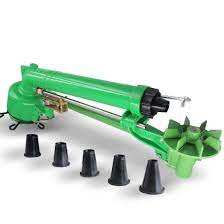
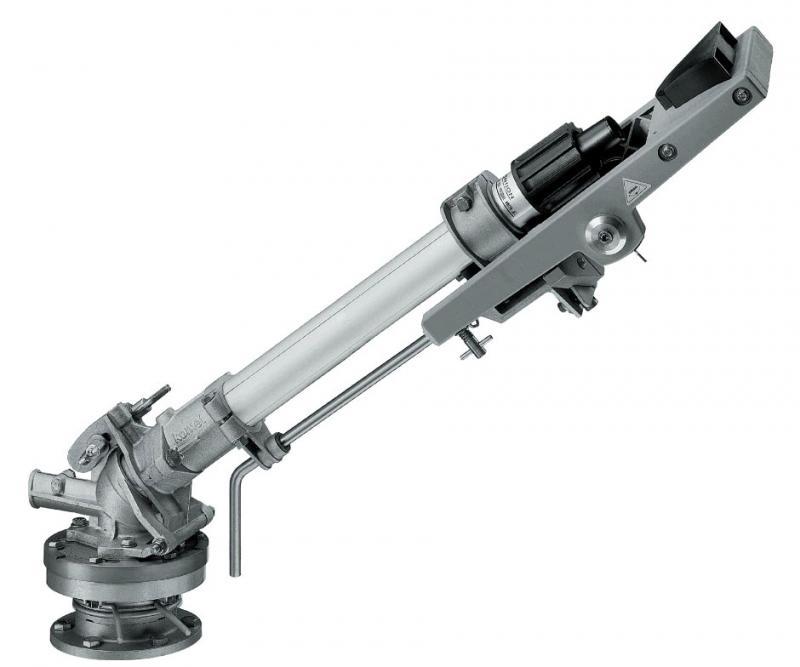
Note that the diameter of spray and discharge volume is a factor of the nozzle size and diesel or electric pump capacity (engine/ motor size, pressure rating, and discharge rate)
How much is a long range sprinkler in Kenya?
- 1-1/2” is Kes 55,000
- 2” is Kes 65,000
This cost is inclusive of the steel tripod stand
How to work with long range sprinkler requirements
i. Water availability. It requires 30 cubic per hour as a minimum. If irrigation takes 5 hours per day, then 150 cubic must be available
ii. Pressure. Check your ground elevation, determine your pressure loss in the system and your pipe size. Work backward to determine the water pump type that matches your sprinkler choice. The frictional losses along the pipeline will be taken into consideration too
iii. Crop water requirement. This determines the time spent in irrigation
iv. Land size. This will determine the number of units to run per session

A long range 2″ rain gun sprinkler on display at Grekkon Limited’s ware house in Athi River
Long range sprinkler
FAQs
1. How much does a sprinkler system cost in Kenya?
The cost of a sprinkler system in Kenya is from Kes 55,000 per acre depending on the sprinkler type and number of sprinklers installed
2. What is the distance of a rain gun?
This is from 17M to 50M diameter of spray
3. How much HP motor is required for a rain gun?
A ran gun sprinkler will work with a fossil fuel powered water pump with an engine power from 7.5Hp
4. What pressure is needed for a rain gun?
From 3 bars or 30M lift
5. How to select a long range sprinkler?
Consider the following
- water volume available
- the water pump specifications
- the lift or ground elevation
- the acreage under irrigation
- your budget
6. What are the benefits of a long range sprinkler system?
- it irrigates over a short period of time saving energy
- it is movable
- there are different sizes to choose from
- it covers both small and large acreage
- it is easy to install
- a large volume of water is provided
- it raises the humidity level around the crop
7. What are the disadvantages of a long range sprinkler?
- it consumes copius amounts of water
- it requires a large water pump for energy
- if left operational for a longer than recommeneded period, it causes soil erosion
- it will not work with gravity flow as the pressure is too low
- it is unsuitable for certain crops because they cause flowe rabortion or make them more susceptible to fungal infections when the foliage is left moist
8. How efficient is a rain gun?
It uses half the water volume that flood irrigation would use. However, it uses more than 3 times what would be achieved under drip irrigation
9. What is the diameter of a rain gun sprinkler?
The diameter of a rain gun sprinkler is from 1″ through 2-1/2″
10. How long does a sprinkler system last?
From 20 years under proper care for the metallic types, and just under 5 years for th plastic analogues
11. How effective is rain gun irrigation?
It is carried out for many crops so long as there is sufficient water volume at the source. It is particularly useful for crops that have large spaces in between
12. What is the difference between rain gun and drip irrigation?
- water application. Rain guns apply from the top (overhead), while drip pipes apply from below
- water efficiency. Drip irrigtaion is more water efficient
- cost. drip irrigation systems are more expensive to install
- crop type. drip irrigation will be used for more crop types than rain gun sprinklers
- rain gun sprinklers unlike drip lines will be installed in uneven terrain
- rain gun sprinklers are preferred most under large acreage
13. How many minutes should I run my rain gun?
Depending on the rain gun size, this is from 15 minutes for the large ones, to 35 minutes for the smaller types. Irrigation is done twice a week
14. How do you maintain your sprinkler system?
- ensure that there are no blockages
- clean any debris stuck
- change or repair any loose springs
- limit the number of operators to one 2 persons only

A 2-1/2″ long range rain gun sprinkler at work
Long range sprinkler
Your long range rain gun sprinkler will have a tripod steel support stand. The water delivery pipe is attached to the hollow bottom of the stand. The diameter size of this hollow bottom is the sprinkler’s size
The water drops are fine to use on flowering crops without causing flower abortion. On solanaceous crops such as; tomatoes, potatoes, peppers, irrigate in the morning hours and not in the evening. This allows the moisture to dry off from the leaves, which minimises blight or mildew infection
Before installation, our technical team makes a site visit to make the system layout plan. This is important to ensure that every inch of the farm is covered during irrigation and that there are no dry shadows
These giant sprinklers irrigate over a short period of time, in a large area

